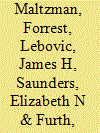| Srl | Item |
| 1 |
ID:
118780


|
|
|
| 2 |
ID:
038683


|
|
|
|
|
| Publication |
London, D C Heath and Company, 1972.
|
| Description |
xxiv, 296p.
|
| Standard Number |
0669820997
|
|
|
|
|
|
|
|
|
|
|
|
Copies: C:1/I:0,R:0,Q:0
Circulation
| Accession# | Call# | Current Location | Status | Policy | Location |
| 011556 | 923.173/LAT 011556 | Main | On Shelf | General | |
|
|
|
|
| 3 |
ID:
150547


|
|
|
|
|
| Summary/Abstract |
Semi-presidential systems develop under the following conditions: if the party system is weak, if the constitution inherits elements of the previous non-democratic system; if strong executive power is required. Weak party system and underdevelopment of political parties encourage personification of party leaders and the presidents, thus the president may place themselves above parties (like Boris Yeltsin did). Personalism becomes the reason for and the consequence of the weak party system, weak parliament and weak democracy.
|
|
|
|
|
|
|
|
|
|
|
|
|
|
|
|
| 4 |
ID:
117571


|
|
|
|
|
| Publication |
2012.
|
| Summary/Abstract |
In this article, we use a multimethod approach to shed light on the strategic use of presidential pets. We draw on primary source materials to demonstrate that pets are an important power center in the White House. Then we turn to presidents' strategic use of their pets in public. We present a theoretical framework and statistical evidence to explore the conditions under which presidents are most likely to trot out their four-legged friends. We show that presidents carefully gauge the best and worst times to conduct a dog and pony show. In times of war or scandal, dogs are welcome public companions, but not so in periods of economic hardship.
|
|
|
|
|
|
|
|
|
|
|
|
|
|
|
|